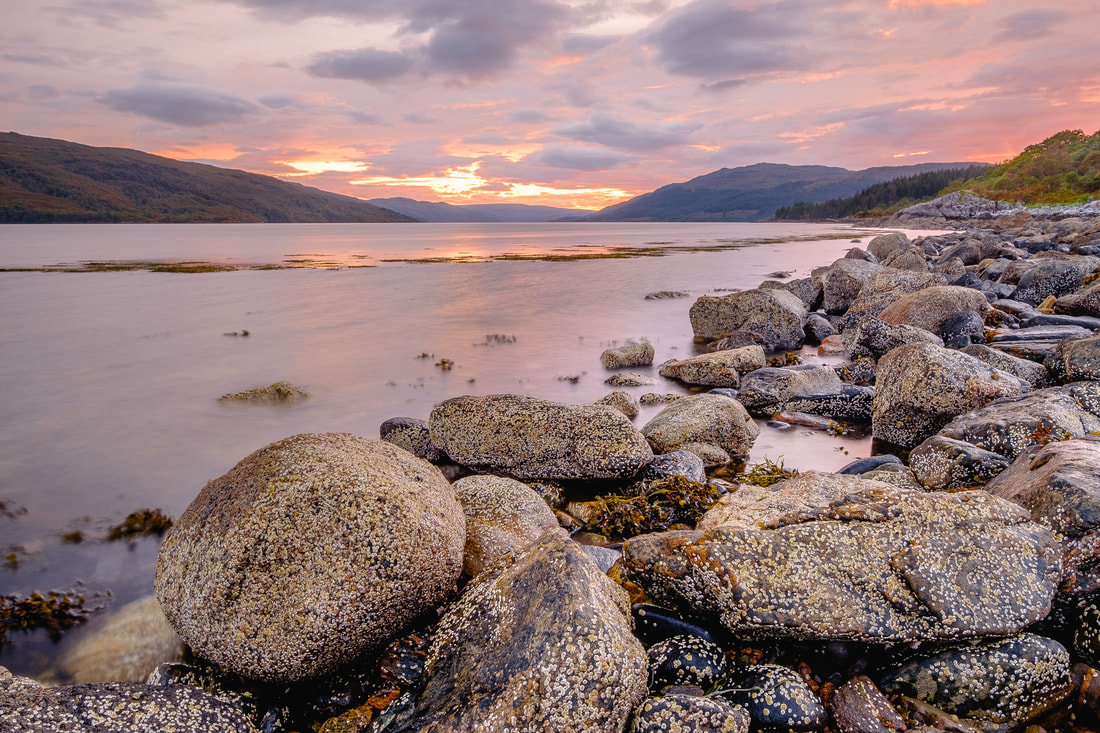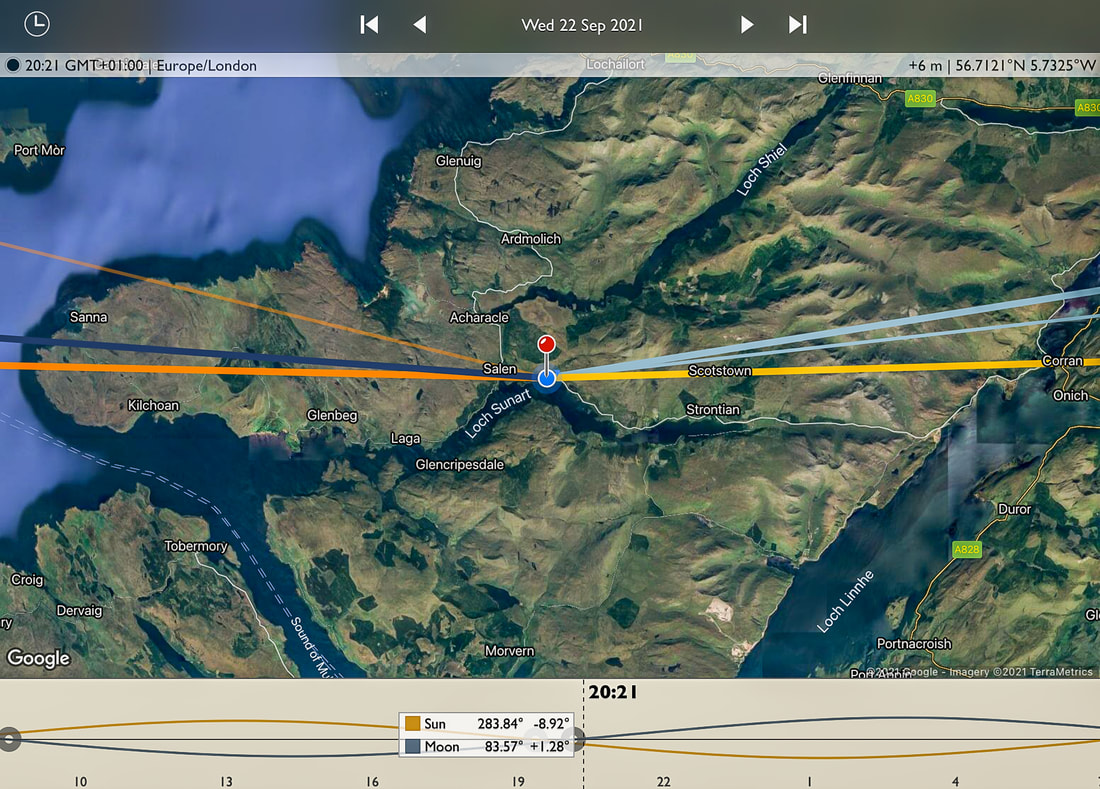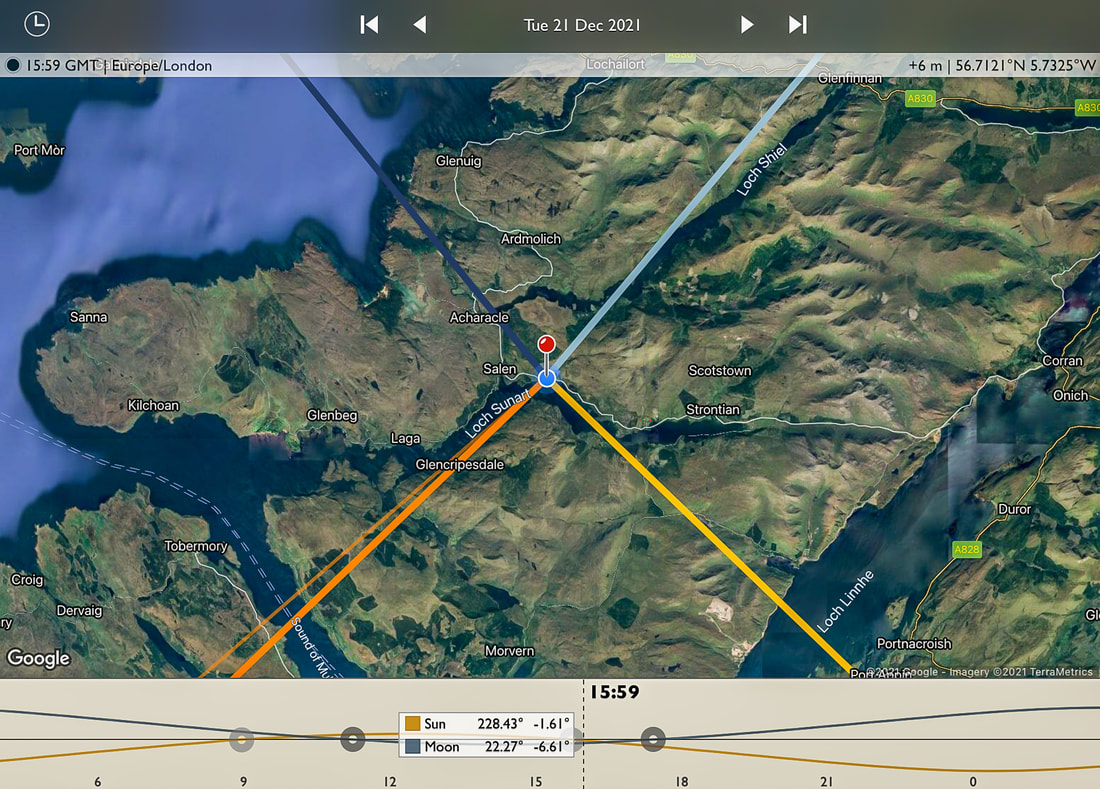|
Depending on your point of view, Autumn either starts on 1 September (meteorological autumn) or on the 23 September (astronomical autumn). The latter is when the Autumnal Equinox takes place and is when day and night are of equal length and when the Sun rises due east and sets due west. Although this means that the dark nights return, it does mark the beginning of the beautiful sunsets over Loch Sunart that we get here at Resipole during the autumn and winter months and also increased chances of seeing the Aurora Borealis. Most people know that the Sun rises in the east and sets in the west, but they may not realise that this is quite a generalisation. In fact, the Sun only rises due east and only sets due west on two days of the year; the days of the Spring Equinox and the Autumnal Equinox which, for 2021, are March 20 and September 22. To illustrate this, Figures 1 and 2 show the location of the rising and setting sun at the Spring Equinox and Autumnal Equinox, respectively. Once it has risen due east and set due west at the Autumnal Equinox (Figure 2), the Sun rises and sets a tiny bit further south each day until the Winter Solstice, the day on which it rises as far to the southeast as it ever does and sets as far to the southwest as it ever does (See Figure 4). It then changes direction and begins moving north each day, eventually rising due east and setting due west on the Spring Equinox (Figure 1) before continuing northwards until the Summer Solstice, when it rises as far to the northeast as it ever does and sets as far to the northwest as it ever does (Figure 3). Once it has risen due east and set due west at the Autumnal Equinox (Figure 2), the Sun rises and sets a tiny bit further south each day until the Winter Solstice, the day on which it rises as far to the southeast as it ever does and sets as far to the southwest as it ever does (See Figure 4). It then changes direction and begins moving north each day, eventually rising due east and setting due west on the Spring Equinox (Figure 1) before continuing northwards until the Summer Solstice, when it rises as far to the northeast as it ever does and sets as far to the northwest as it ever does (Figure 3). Image 1, at the top of this blog, was taken at Resipole during sunset on the day after the Autumnal Equinox of 2019, with the camera facing southwest down Loch Sunart towards the Isle of Carna and the hills of Morvern. If you look closely, you can see a patch of intense colour behind the wooded hillside on the right-hand side of the image. This was the spot where the sun was setting due west and for me, such a sight is one of the most welcome of the year because it marks the return of spectacular sunsets to this part of the Loch. With the passing of the autumn months and the movement of the setting sun towards the south, these sunsets become more and more intense. They are something that I’ll never tire of photographing even though I have taken countless photos of them from this spot. I can honestly say that I’ve never seen the same mix of colours twice. Each sunset is different because of the varying position of the sun and the infinite range of possible cloud formations that reflect the light from the sun and produce the kaleidoscope of colours. The Autumnal Equinox also paves the way for increased chances to see aurora borealis displays. According to NASA, the equinoxes are prime time for Northern Lights, because the geomagnetic activity that causes them is more likely to take place in the spring and autumn than in the summer or winter. In addition, we tend to have more clear nights in spring and autumn so this, combined with more geomagnetic activity, may be the reason why I tend to have captured most of my Northern Light images in September/October and March/April. Image 2 above was taken 4 days after the Autumnal Equinox of 2019, when I had a client out with me for some night photography tuition. We had spent the first part of the night preparing for and taking photographs of the Milky Way rising above Loch Sunart and while we were doing this a very high Aurora Alert came through on my phone. We quickly packed up our camera gear and headed up to Acharacle and set it up again on the jetty there is on Loch Shiel. It is a perfect spot to look for and photograph the Aurora Borealis because it faces directly towards northern horizon that has only a few distant and low-lying hills on it, meaning that the view north is clear of any obstructions. We had a very productive time there and also at another couple of locations nearby and came away with some great shots of the “Merry Dancers”.
Finally, although the equinox referred to as a day by many people, it is actually the exact moment in time when the tilt of the Earth’s axis and Earth’s orbit around the sun combine in such a way that the axis is inclined neither away from nor toward the sun. For 2021, the Autumnal Equinox will be at 8:21 pm on Wednesday 22 September and the Spring Equinox was at 9:37 am on Saturday 20 March.
0 Comments
Your comment will be posted after it is approved.
Leave a Reply. |
AuthorHi, Archives
July 2024
Categories
All
|
Steven Marshall Photography, Rockpool House, Resipole, Strontian, Acharacle, PH36 4HX
Telephone: 01967 431 335 | Mobile: 07585 910 058 | Email: [email protected]
Telephone: 01967 431 335 | Mobile: 07585 910 058 | Email: [email protected]
All Images & Text Copyright © 2024 - Steven Marshall - All Rights Reserved







